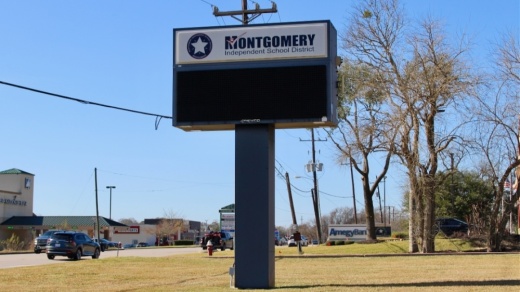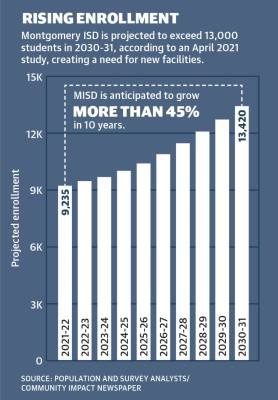The district is projected to enroll an additional 4,000 students by the 2030-31 school year with several schools exceeding capacity by that time, according to an April 2021 report from demographics firm Population and Survey Analysts.
“The growth is coming. You can drive around; you can see it. We’re not making that up. These kids are coming; we’re required to educate them,” said Kris Lynn, assistant superintendent of finance and operations, in an interview.
MISD trustees voted Feb. 15 to place three propositions on the May ballot. Proposition A totals $312.98 million for facility improvements, buses, and upgrades to make old and new campuses comparable. Proposition B totals $8.51 million for athletic renovations, and Proposition C includes $5.4 million for technology devices.
If all three propositions are approved by voters, the district anticipates the overall tax rate would increase less than $0.01 per $100 valuation, and if a statewide proposition to raise the homestead exemption also passes May 7, some voters could see tax savings despite the anticipated MISD tax rate increase, Superintendent Heath Morrison said.
Big-ticket items in the bond include a seventh elementary school, a 900-student expansion to Lake Creek High School, a centralized CTE facility and a centralized agricultural science center as well as smaller projects, such as new buses, technology and renovations to the MISD Athletic Complex, according to district information.
“Unfortunately, all these bonds are full of great ideas, but they come with a pretty hefty price tag. And most of us that are opposing these bonds are looking for governments to start reining in their spending,” said Amy Hedtke, an organizer of a Facebook group titled It’s OK to Vote NO on BOND$, which seeks to mobilize voters across Texas who are opposed to school bond packages. “There’s a lot of neat things that sound great, but when you can’t afford them, you can’t afford them.”
According to the district, voters approved the last bond in 2015, totaling $256.75 million.
“If this bond doesn’t pass, then some of those things still have to be done,” Lynn said. “If we don’t have these bond dollars to do it, then it has to shift to that operational budget, which means we don’t get the opportunity to do something else.”
Workforce needs
In addition to accommodating enrollment growth, the bond package addresses a need for more CTE space, a department the district has focused on for the past two years by hiring a new CTE director and adding programs, Morrison said in an interview. According to a benchmark set in the district’s 2021-24 strategic plan, 78% of students participated in at least one CTE course in the 2020-21 school year with a goal of 90% of students participating by the end of the 2024-25 school year.
"Some of these programs are very dependent on the instructional space. If you’re going to teach students culinary arts, it’s really difficult to do it in a classroom that was built to be a math classroom,” Morrison said.
The proposed $61.61 million centralized CTE facility would provide certification opportunities to students and improve operational and facility efficiencies by avoiding two separate high school facilities, he said. The district could also add programs the community could benefit from, such as automotive technology and cosmetology, Lynn said.
“I know that there’s a lot of businesses locally that see the value and are ready to partner with us on this,” board President Matt Fuller said in an interview.
Funding a bond
If approved by voters, Lynn said bond funds must be spent on the projects outlined; funds cannot be used for daily operations, such as pay raises, because bonded debt is paid by the interest and sinking portion of the overall tax rate. The maintenance and operations portion of the tax rate funds daily operations.
“There are certain things that you can’t handle if you’re in a fast-growing school district, and ... you’ve got to put kids in schools, and you have to make sure that they’re not in overcrowding and unsafe environments,” said Greg Smith, executive director for the Fast Growth School Coalition.
As a fast-growth district, MISD’s $80 million annual budget—about the cost of two elementary schools—is stretched to fund capital projects on top of daily operations, Morrison said.
“A purchase of one bus is about three teachers. Every time you’re purchasing one bus out of that M&O budget, that’s three teachers that you can’t hire,” he said.
Although the approval of the propositions would raise the tax rate from $1.26 per $100 of valuation to $1.267 per $100 of valuation, Lynn said MISD’s rate is at its lowest since 2005.
The anticipated tax rate increase would equate to a $22.75 increase per year on the average home valued at $350,000. However, homeowners over age 65 who have filed a property tax exemption would not see an MISD tax rate increase, district officials said.
Should a statewide proposition increasing the homestead exemption for school districts from $25,000 to $40,000 also be approved, Lynn said the average $350,000 homeowner would pay $167.30 a year less to MISD.
“[Residents] will reap the benefits of an educated citizenry,” Fuller said.
Maegan Kirby contributed to this report.








